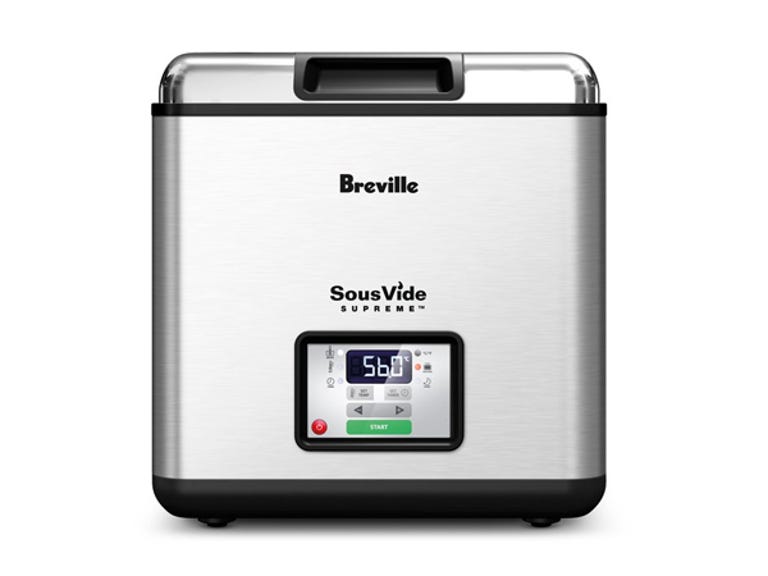 Why You Can Trust CNET
Why You Can Trust CNET Breville Sous Vide Supreme review: Breville Sous Vide Supreme
Unless you have a lot of time and money to throw at a new kitchen gadget, the Breville Sous Vide Supreme may end up nothing more than a very expensive novelty.
Sous vide is a method of cooking that involves vacuum sealing your food in plastic and cooking it in a water oven — that is, a tightly temperature-controlled bath of water, usually at a relatively low temperature compared to more traditional cooking methods, over a longer period of time.
The Good
The Bad
The Bottom Line
Sous vide, French for "under vacuum", is said to have several advantages: the lower temperature allows a more even heat penetration throughout the food, resulting in food that is cooked more evenly, while vacuum sealing the food allows it to cook in its own juices, maintaining flavour and removing the need for pan-greasing agents, such as butter, fat or oil. Many high-end restaurants use sous vide to pre-cook steaks, for example, because it ensures the same result every time, removing the guesswork.
As sous vide moves out of the restaurant and into the home, we got to test drive one of the few sous-vide machines on the Australian market: the Breville Sous Vide Supreme.
At 29x29x36 centimetres, it's a hefty beast, taking up quite a bit of kitchen bench real estate. If you think it's something you'll use fairly often, that real estate might be worth it, but it comes with a few caveats. The first is that food does take longer to cook. As you can see in our video, medium steaks and salmon take at least 40 minutes, and that's not taking into account browning. (When you cook food sous vide, you lose the Maillard reaction, the chemical reaction that turns the food brown and crispy, because the outside temperature isn't high enough for searing.)
On the plus side, you can just set and forget, walking away for that time and letting the sous-vide machine work its magic; or you can use that time to prep the rest of the meal. One thing we particularly liked was the idea of vacuum sealing up a bunch of food, sticking it in the freezer and pulling it out and popping it in to cook as needed, no thawing required, and because the food doesn't come into contact with the water, you won't need to change it with every use.
Of course, when you are using it, you do need to let the water warm up (unless you're comfortable leaving the machine plugged in while you're out all day, as you do with your fridge), and putting frozen food in rather than refrigerated or room temperature means you add yet more minutes to the cooking time. If you're making yourself a meal after a day at work, anything that adds to the cooking time is generally considered a negative. One way around this would be to put your food in to cook before you leave in the morning — with sous vide, there's no such thing as overcooking, or so we've been told.
There's also a lot you can do: marinade meat and let it cook in the marinade, slow cook for 36, 48 or even 72 hours for a cut that falls apart in your mouth, cook veggies (although we'd be less inclined to cook vegies for 48 hours) and even poach eggs (we don't recommend cooking frozen dumplings sous vide, however). Because the food is vacuum sealed, it doesn't suffer the same rate of decomposition as other meat and won't dry out while cooking.
But... about that vacuum sealing. You need to buy a separate machine for that, the AU$129.95 Fresh Keeper; it doesn't come packaged with the Sous Vide Supreme. You also need to purchase the bags for sealing — you can buy a roll for AU$29.95, bringing the price up to AU$959.95. Unless you're going to be using it every day, and most won't, that seems pretty expensive.
We also found the control panel quite fiddly. The temperature is set in half-degree increments and the time in minute increments, by pressing arrow buttons; with no number keys, it feels quite fiddly and clunky. It's also counter-intuitive: once you set the timer, the display will revert to the temperature, meaning if you want to see how much time you have left, you have to press the "Set Timer" button to do so. Having the temperature constantly displayed also allowed us to see that the temperature fluctuates quite a bit — at least a degree or two up and down. For something like eggs, which are very temperamental, this could mean you don't quite get the results you desire — Nic's poached eggs, while tasty, came out hard in the yolk and runny in the white, which is the very opposite of excellent eggs.
The lean steaks we cooked came out rather tough, so we suspect some percentage of fat is required to keep the meat tender — this is not, we note, a problem with the machine so much as us figuring out what works and what doesn't; the salmon was utterly perfect.
We feel that there's a deal more experimentation we can do with the Sous Vide Supreme, and to be honest, we think that will be fun; but we didn't pay nearly $1000 for the kit and kaboodle. If you have the money and like tooling around in the kitchen, then a sous vide machine would be right up your alley. For anyone who's low on time (and bench space), it might be a little more effort than it's worth.


